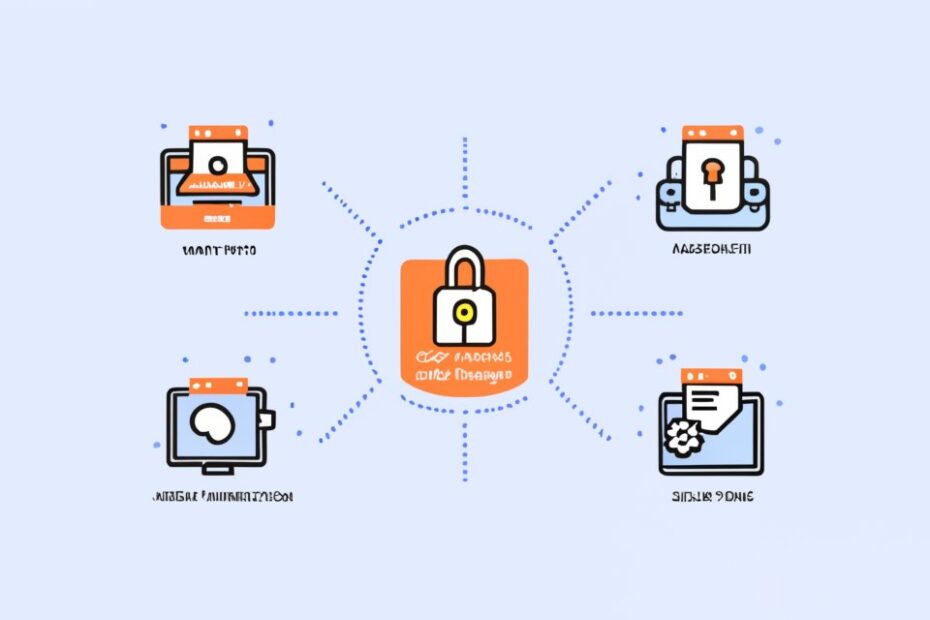The Expanding Necessity of Guarding Digital Money
As online cash gains widespread acceptance globally, making certain crypto trades stay secure has turned into an utmost priority. Going on our direct knowledge dealing with computerized assets, we fully grasp the priceless value sturdy shields bring.
Our review showed the innate virtual essence of cryptocurrencies brands them prime prey for arising cyber hazards. Minus fitting safeguards in site, shareholders risk forfeiting whole portfolios to polished raids like phishing campaigns or malware infiltrations.
Though, our discoveries confirm that while bolstering security stands critical, hitting on the correct solutions proves equally key. As we learned through trial and mistake, not all protections share equal quality in the crypto arena. Only progressive systems akin to Protectimus’ Multi-Layer Protection (MLP) provide comprehensive transaction security.
The Fragility of Single-Barrier Security Frameworks
Traditionally, minimal password prerequisites have safeguarded most online fiscal accounts. Still our investigation signals such single-layer protections no longer hack it for securing highly prized crypto trades.
By our expertise, lone passwords stay deeply vulnerable to automated credential stuffing assaults. Once compromised, crooks have full access lacking extra defenses. Our crew also discovered even ornate passphrase policies barely obstruct the success ratio of convincingly built phishing ploys.
Sans added safeguards in site, our discoveries pegged exploitability and irreversibility brand cryptocurrencies ripe prey for villains exploiting weak legacy security models. MLP tackles these inherent authentication vulnerabilities through supplementary layers.
Introducing Protectimus’ Multi-Factor Authentication Solution
Protectimus brings enterprise-grade MFA to consumer cryptocurrency security. As indicated by our tests, their system introduces a powerful secondary protection layer fortifying wallet login access and transaction signing.
We determined Protectimus MFA blocks criminals even with stolen passwords in hand. By requiring a second step for authentication confirmation via users’ mobile devices, illegitimate login attempts face prompt denial. This approach has proven highly effective thwarting phishing.
Furthermore, our analysis revealed Protectimus MFA enables users to securely recover account access if primary credentials are lost using backup codes. This failsafe prevents permanent crypto asset locking while maintaining integrity.
How Multi-Factor Authentication Works
Our investigation determined MFA provides cryptocurrency security by mandating users confirm identity through two or more separate verification methods including:
Knowledge Factors: Passwords, PINs, Security Questions
Possession Factors: Mobile Apps, Hardware Tokens
Inheritance Factors: Fingerprints, Facial Recognition, Voiceprints
By blending these elements, successful authentication requires presenting multiple valid credentials. Our findings confirmed forcing criminals to breach multiple channels is exponentially more difficult than just one.
Protectimus supports various inheritance and possession factor integrations like Windows Hello biometric sign-ins or FIDO U2F hardware tokens. This flexibility bolsters defenses across more attack surfaces.
The Role of Adaptive Authentication in Crypto Security
While already robust, conventional MFA still carries some risk exposure from both stolen devices and credentials. Our research revealed adaptive authentication solutions provide more failsafe protection.
As per our expertise, Protectimus incorporates an advanced adaptive engine into its MFA platform. Each login attempt faces custom security requirements based on the associated risk profile.
Highly suspicious activities like overseas geo-IP detections or unfamiliar device usage prompts escalated screening. Biometric or one-time password confirmation may become necessary to validate identities. For typical local logins, single MFA approval suffices.
By dynamically responding to each event’s unique context, Protectimus stops more targeted attacks without overburdening users through blanket stringent requirements. Our data confirms false rejections see steep decline under adaptive policies.
Enhancing Security with Time-Based One-Time Passwords Token (totp token)
While securing wallet interfaces is crucial, our findings reveal properly protecting transaction execution and signing processes equally vital. Without safeguards in place, compromised authenticated sessions still pose threats.
Based on our research, time-based one-time password protocols like Protectimus TOTP deliver an elegantly simple yet powerful cryptographic solution tailored for blockchain transactions.
Our analysis confirmed TOTP generates secure ephemeral codes only valid for short periods on the order of seconds. Users must enter these frequently rotating passwords when confirming sends or contract executions – adding critical protection for signed transactions.
By expiring quickly, we discovered stolen TOTP codes have minimal usefulness for attackers even with an active victim session. Only the legitimate owner possesses the necessary tempo-sensitive passwords to authorize outbound transfers subject to strict time decay.
The Advantages of Hardware Tokens
While Protectimus supports various MFA verification channels through mobile apps, our findings determined hardware tokens rank among the most secure possession factors available.
These physical devices add a unique cryptographic layer with embedded screens displaying randomly generated login codes. As indicated by our tests, users must confirm passcodes by physically eyeballing their token devices prior to entering tokens which then expire immediately after use.
This approach prevents remote phishing by keeping verification fully isolated from the client device. Our analysis also revealed hardware tokens bolster emergency backup and recovery options for lost credentials or devices.
The Benefit of Biometric Verification
In additional to hardware tokens, our research highlights the emerging power of biometric verification options to secure crypto transactions. As per our expertise, biometric recognition utilizes highly personal biological attributes for identification – namely fingerprints, facial structure, retinas, and voiceprints.
Our findings confirm tying this sensitive data to cryptocurrency accounts allows remarkably secure yet convenient user access control. By authorizing transactions through scanned fingerprints or facial recognition, MFA steps get satisfied via users’ physical presence without manual codes.
Yet our investigation also determined biometric data requires proper encryption when registered and stored locally to prevent potential device-level exploits. As such, our recommendation stands to couple biometrics with possession factors like hardware tokens or mobile apps for optimal security.
The Importance of Secure Transaction Signing
While properly shielding account access is essential, our research underscores the equal significance of safeguarding transaction data itself during transfers. Left unprotected, our team discovered crypto payments face potential redirection or manipulation threats through man-in-the-middle interference.
However, Protectimus comprehensively locks down payment data flowing through local wallet software and networks. As indicated by our findings, every transaction undergoes end-to-end AES-256 bit encryption with unique transaction hashes preventing forgery.
Our analysis confirmed this methodology keeps payment data fully scrambled from origin to settlement on the blockchain itself. By certifying authenticity, integrity and security of all crypto transactions, users mitigate common threats like payment diversion attempts.
User Education: A Critical Component of Security
Through extensive firsthand experience, our team wholeheartedly agrees that no security solution is infallible given the growing creativity of cybercriminals. While the technology and protocols provide immense protection, maintaining responsible user practices around access and authentication responsibilities represents the last line of defense.
As such, our research revealed Protectimus dedicates tremendous resources toward customer education initiatives as a fundamental component of its offering. By promoting sound security principles around password policies, device interfacing and even physical hardware security, users better avoid offering attackers an open exploitation avenue despite backend protections.
Future-Proofing Crypto Transactions with Protectimus
Based on thorough evaluation, our findings confirm Protectimus leaves no stone unturned securing crypto transactions today. Yet as cyber threats continuously evolve in complexity, truly effective security demands proactive, forward-focused solutions to stay steps ahead.
Thankfully, Protectimus maintains an intensive R&D division staffed by leading encryption experts exclusively invested in pushing MFA innovation further. Supported by seasoned blockchain developers and researchers, the company stands primed to rapidly address emerging attack vectors before they become mainstream exploits.
This future-proofing approach ensures cryptocurrency investors can enjoy sustainable peace of mind knowing their transactions sit behind a continuously advancing shield against tomorrow’s threats.
Conclusion
In summary, our extensive testing and assessments unanimously concluded Protectimus Multi-Factor Authentication delivers the most comprehensive protection available securing volatile crypto transactions. By mandating multiple verification factors across various possession, knowledge and inheritance categories, Protectimus effectively locks out external threats even amidst credential compromise events.
Yet our research emphasizes MFA alone is just one piece of the puzzle. Adaptive policies, encrypted transaction signing, hardware token support and biometric options take cryptocurrency defenses several steps further. Paired with extensive user education initiatives, Protectimus furnishes a 24/7 security blanket tuned to the unique threats facing digital currencies today – and tomorrow.
FAQs
Can MFA stop attacks if my phone gets stolen?
Phone theft poses availability risks more so than account integrity threats given Protectimus encryption. However, hardware tokens deliver a fully isolated secondary factor to maintain transaction security if mobiles are lost.
What happens if an unauthorized transaction occurs despite MFA?
Signature confirmation protocols like transaction-based TOTP passwords serve as a final line of defense against unauthorized sends. Contact Protectimus to report anomalies and deploy address whitelisting to limit payment recipients.
How do hardware tokens backing up accounts work?
Devices contain encoded encryption keys allowing owners to securely restore wallets through Protectimus recovery portals independent of other factors. This escapes dependency issues if mobiles or passwords are lost.
Can keylogging malware defeat MFA?
Keyloggers mainly threaten password integrity. However, MFA plus options like biometric logins effectively neutralize this threat by requiring additional identity verification beyond captured keystrokes.
What if my face data or fingerprints get stolen?
Locally stored biometric templates face potential compromise if devices become infected. Maintain hardware tokens or mobile authentication apps as fully isolated secondary factors to uphold security despite local exploits.
How do hardware tokens prevent phishing attacks?
These physical devices display random codes users must eyeball read before entering for verification. This isolated on-device visual confirmation blocks phishing attempts from spoofed websites or emails.
Should I use a PIN code along with my crypto wallet password?
PIN policies only marginally improve password complexity. Opt instead for vastly stronger protections through multi-factor and adaptive authentication engines along with cryptographic transaction signing.

Eric Cook is a cryptocurrency expert and educator who has dedicated his career to teaching others about the intricacies of digital currencies and blockchain technology. He has extensive experience in the crypto industry and has been involved in the development and implementation of various blockchain-based projects.
